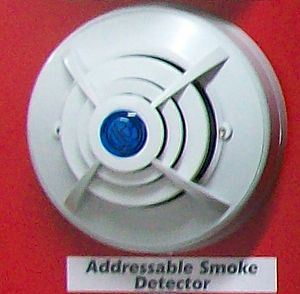Smoke detector facts for kids
A smoke detector is a clever device that can sense smoke. Smoke often means there's a fire nearby. There are two main types. Simple ones just make a loud sound or flash a light when they find smoke. Bigger, more advanced ones send a signal to a central fire alarm system.
Most smoke detectors use one of two ways to find smoke: an optical sensor or a process called ionization. Many simple smoke detectors run on batteries. It's super important to change old batteries, because a dead battery means the detector won't work! Luckily, most detectors will "chirp" to let you know the battery is low. Some detectors connect directly to your home's electricity and use batteries only as a backup.
Smoke detectors usually come in a round plastic case, about 150 millimetres (6 in) wide and 25 millimetres (1 in) thick. They can find smoke using light (photoelectric) or by changing the air (ionization). Some detectors use both methods. Very sensitive alarms can even help stop people from smoking in places where it's not allowed.
In large buildings like schools or factories, smoke detectors are often part of a big fire alarm system. This system runs on the building's power and has battery backups. For homes, you can have single battery-powered detectors or several detectors linked together. If one linked detector finds smoke, all of them will sound the alarm, even if the power is out.
Contents
How Smoke Detectors Work
Photoelectric Detectors
Photoelectric smoke detectors look for changes in light. They have a light source, like an infrared or visible light beam, inside them. When smoke enters the detector, it blocks or scatters this light.
The detector notices that less light is reaching its sensor. If the light level drops below a certain point, the alarm goes off. It's like a tiny light switch that flips when smoke gets in the way.
Ionization Detectors
Ionization smoke detectors use a tiny bit of a radioactive element. This element releases tiny Alpha particles that charge the air particles inside the detector. This creates a small electric current.
When smoke enters the detector, the smoke particles attach to these charged air particles. This changes the electric current inside the detector. When the current changes, the detector knows there's smoke and sounds the alarm.
Ionization smoke detectors are often cheaper than photoelectric ones. However, they can sometimes cause more false alarms, like from cooking fumes. They also tend to react a bit slower to real fires, especially those that start with a lot of smoke.
Images for kids
-
Inside a basic ionization smoke detector. The black, round structure at the right is the ionization chamber. The white, round structure at the upper left is the piezoelectric horn that produces the alarm sound.
See also
 In Spanish: Detector de humo para niños
In Spanish: Detector de humo para niños








